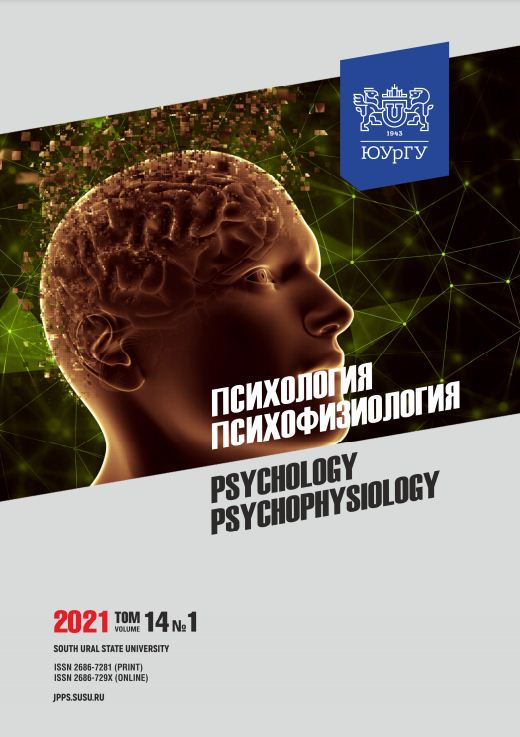THE ROLE OF MICROSOCIAL FACTORS IN FORMING RISKY BEHAVIOR IN CHILDREN
Abstract
Abstract. The article presents data on factors that contribute to repeated injuries in children aged 5–10 years. Family factors as well as the necessity to distinguish between true and false hyperactivity in children were revealed. Aim. The article aims to identify microsocial factors of risky behavior in children. Materials and methods. A total of 450 patients (225 children and 225 family members) were observed. Research tools: standard neuropsychological tests, Alvord and Baker hyperactivity test, psychoneurological examination, a psychological portrait of a parent/teacher by G.V. Rezapkina and the author’s techniques (“How do I see my child”, “Subjective evaluation of parents and their education style”). Results: True hyperactivity disorders were revealed in no more than 12% of children. Thus, the majority of children are characterized by pseudo-hyperactivity. To reduce the risk of injury, it is necessary to differentiate between two types of pathogenic factors: minimal brain dysfunction (biological) and parental behavior (social). Conclusion. In our research risky behavior is considered to be a child’s behavior in a situation that increases the risk of a child to be injured. The outcome of such a traumatic situation is the result of both children and parents’ activity. A child tries to cope with both biological (less often) and social (mainly) factors by means of hyperactivity.
Downloads
References
2. Garzon D.L. Contributing factors to preschool unintentional injury. J. Pediatr Nurs. 2005; 20(6): 441–447. DOI: 10.1016/j.pedn.2005.03.014.
3. Hyder A.A., Sugerman D.E., Puvanachandra P. et al. Global childhood unintentional injury surveillance in four cities in developing countries: a pilot study. Bull World Health Organ. 2009; 87(5): 345–352. DOI: 10.2471/blt.08.055798.
4. Ordonana J.R., Caspi A., Moffitt T.E. Unintentional Injuries in a Twin Study of Preschool Children: Environmental, Not Genetic, Risk Factors. Journal of Pediatric Psychology. 2008; 33 (2): 185–194. DOI: 10.1093/jpepsy/jsm041
5. StGeorge J., Fletcher R., Freeman E. et al. Father-child interactions and childrens risk of injury. Early Child Development and Care. 2015; 185 (9): 1409–1421. DOI: 10.1080/03004430.2014.1000888
6. Azar S.T., Miller M.T., Stevenson D.R. et al. Cognition, child neglect, and child injury risk: the contribution of maternal social information processing to maladaptive injury prevention beliefs within a high-risk sample. Journal of Pediatric Psychology. 2017; 42 (7): 759–767. DOI: 10.1093/jpepsy/jsw067.
7. Ablewhite J., Peel I., McDaid L. et al. Parental perceptions of barriers and facilitators to preventing child unintentional injuries within the home: a qualitative study. BMC Public Health. 2015; 15: 280. DOI: 10.1186/s12889-015-1547-2.
8. Schnitzer P.G., Dowd D., Kruse R.L. et al. Supervision and Risk of Unintentional Injury in Young Children. Injury prevention. 2015; 21: 63–70. DOI: 10.1136/injuryprev-2013-041128
9. Morrongiello B.A., Matheis S. Understanding Childrens Injury-risk Behaviors: The Independent Contributions of Cognitions and Emotions. Journal of Pediatric Psychology. 2007; 32 (8): 926–937. DOI: 10.1093/jpepsy/jsm027.
10. Davis C.S., Godfrey S.E., Rankin K.M. Unintentional injury in early childhood: its relationship with childcare setting and provider. Maternal and Child Health Journal. 2013; 17 (9): 1541–1549. DOI: 10.1007/s10995-012-1110-z
11. Acar E., Dursun O.B., Esin İ.S. et al. Unintentional injuries in preschool age children: is there a correlation with parenting style and parental attention deficit and hyperactivity symptoms. Medicine (Baltimore). 2015; 94 (32): e1378. DOI: 10.1097/MD.0000000000001378.
12. Golovko О.V., Borshchuk E.L., Pavlenko T.N., Begun D.N. Medical and social risk factors affecting the occurrence of injuries in children. Sovremennye problemy nauki i obrazovaniya = Modern problems of science and education. 2017; 2. Available at: http://science-education.ru/ru/
article/view?id=26172 (accessed: 19.10.2020). (in Russ).
13. Schwebel D.C. Why "accidents" are not accidental: Using psychological science to understand and prevent unintentional child injuries. American Psychologist. 2019; 74 (9): 1137–1147. DOI: 10.1037/amp0000487
14. Bradbury K., Janicke D.M., Riley A.W., Finney J.W. Predictors of unintentional injuries to school-age children seen in pediatric primary care. Journal of Pediatric Psychology. 1999; 24 (5): 423–433. DOI: 10.1093/jpepsy/24.5.423.
15. Andrejeva J., Kasradze M., Mockiene A. The impact of TRX suspension training on patients balance, coordination and quality of life after traumatic brain injury. J. Georgian Med News. 2020; 298: 119–122. Available at: https://pubmed.ncbi.nlm.nih.gov/32141863/
16. Sturms L.M., van der Sluis C.K., Groothoff J.W. et al. Eisma Characteristics of injured children attending the emergency department: patients potentially in need of rehabilitation. Clin. Rehabil. 2002; 16: 46–54 DOI: 10.1191/0269215502cr466oa.
17. Zhang H., Li Y., Cui Y. et al. Unintentional childhood injury: a controlled comparison of behavioral characteristics. BMC Pediatr. 2016; 29: 16–21. DOI: 10.1186/s12887-016-0558-1.
18. Zakharchuk E., Dotsenko E., Khvesko T. et al. Neuropsychological and/or psychological factors traumatic behavior of children under the age of 10 years. International journal of psychology:
a biopsychosocial approach. 2020; 23. DOI: 10.7220/2345-024X.23.8
References on translit
.Copyright (c) 2021 Psychology. Psychophysiology

This work is licensed under a Creative Commons Attribution-NonCommercial-NoDerivatives 4.0 International License.



